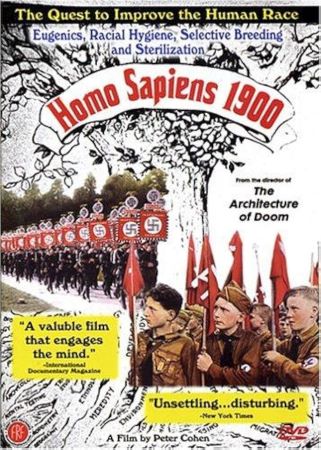
Homo Sapiens 1900 1998
Distributed by First Run/Icarus Films, 32 Court St., 21st Floor, Brooklyn, NY 11201; 800-876-1710
Produced by Peter Cohen
A film by Peter Cohen
VHS, color, 84 min.
College - Adult
Sociology, History, Eugenics
Date Entered: 11/09/2018
Reviewed by Andrea Slonosky, Long Island University, Brooklyn CampusAt the end of the 19th century some European scientists and academics saw that the evolution of man was at odds with the evolution of (western) civilization. As living conditions and medical care improved, more and more humans who might have died before passing on their genes were in fact living long enough to bear and raise children. These people then passed on the undesirable traits they possessed to their children, thus perpetuating a bloodline that should have died out shortly after it was established. To sum it up, it was felt that 'inferior people reproduced more rapidly.'
The philosophy of eugenics and race hygiene was based on the quest for the perfect, pure race, as represented in classical art. The movement gained a widespread acceptance in the xenophobic, empire-building West, and was rapidly incorporated into governmental policies in Europe and the US.
Practically, eugenics could be applied in two ways: negative and positive. Positive eugenics encouraged good specimens to mate and produce racially pure and genetically sound offspring. In effect, this was the desire to inject the practice of love with the logic of science, and was as difficult to practice and prove scientifically as the paradox implies. Negative eugenics was the removal of inferior specimens. This was much easier to carry out, and allowed doctors to refuse treatment to deformed newborns, or to sterilize the insane. In Sweden, these polices were a foundation of the nations social policy, and were only repealed in the 1970's.
A large part of the film focuses on the ideological split between the two branches of this science: the Mendelianist and the Lysenkoist. The Mendelians believed that heredity alone was responsible for the development of physical and mental traits, while the Lysenkoists believed that some traits were acquired through an environmental exposure, and that these acquired traits could be passed on through biological reproduction.
These beliefs found their logical expression in Nazi Germany and Soviet Russia. The Nazis concentrated their medical and genetic studies on developing a perfect race, and practiced the extreme form of negative eugenics by exterminating those who didn't conform to the ideal of the master race. The Soviets were dedicated to the idea of environment -the ideas of genetic inheritance were deemed to be anti-revolutionary, as they permitted no hope for the proletariat to develop to the level of the intelligentsia. The Soviet efforts were devoted to finding the source of genius.
Although the filmmakers painstakingly describe the details of the breach, discussion of the Holocaust as an expression of eugenics, or of Stalin's purges, is not detailed in any way. There is also no discussion of the eugenic basis of the Swedish social welfare system - it is mentioned, but not described. There are multitudes of photographs taken by eugenicists, showing the front, back and profiles of a range of subjects, along with many group photographs of people, which are meant to show the ideal and the deviation from the ideal, which the eugenics movement sought to control. Reference is made to the anthropological foundations for these practices, but these practices and these photographs are never explained or addressed. Viewers who come to this film with a poor understanding of the development of science, social sciences and political thought towards the end of the 19th century might find themselves lost in a sea of inferences and implications
This is a slow, stately film, consisting of a succession of still photos intercut with the occasional film clip. The subject is fascinating, but the film is frustrating. The narration is measured and clearly enunciated, although the tone of voice never changes. Over the course of the 88-min film, it becomes more and more difficult to pay attention and absorb the information being presented. Each segment is separated by several seconds of silence, accompanied by a black screen, which gives the instructor a chance to stop the film for discussion. Many of the photographs are nudes, although there is no sexual content.
This film would be most useful to an academic or special library. This film is recommended. .